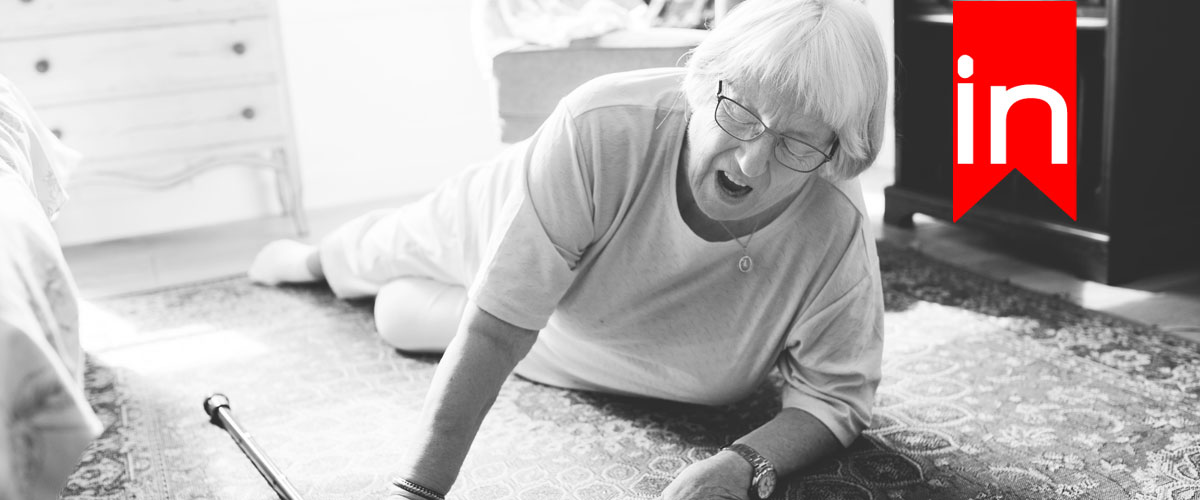Falling injuries are a major concern for the elderly in Canada, particularly in their own homes. According to data collected by Statistics Canada, accidental falls are the leading cause of injury-related hospitalizations for seniors in the country. The majority of these falls occurred in the home or surrounding area, with factors such as poor lighting, cluttered spaces, and lack of safety equipment contributing to the risk.
Injuries resulting from falls can have serious consequences for seniors, including reduced mobility, loss of independence, and even death. While not all falls result in injury, those that do can have a significant impact on the health and wellbeing of older adults. As the population of seniors in Canada continues to grow, it is important to understand the risk factors for falling injuries and take steps to prevent them. This may include modifications to the home environment, such as installing grab bars and removing tripping hazards, as well as regular exercise and medical check-ups to maintain overall health and mobility.
Highlights
- Falling injuries are a major issue for Canada’s elderly, leading to serious consequences like reduced mobility. Key preventive measures include home modifications and regular exercise.
- Studies show falls are the leading cause of injury hospitalizations among seniors, especially hip fractures. Addressing risk factors such as medication side effects is essential for prevention.
- Future research should assess fall prevention strategies’ effectiveness and explore the long-term impacts of fall-related injuries to enhance elderly care.
Epidemiology Of Falls Among Elderly In Canada
Falls among the elderly in Canada are a significant public health concern. According to the Canadian Community Health Survey, in 2018, 20% of Canadians aged 65 and over experienced at least one fall in the previous year. Falls are the leading cause of injury-related hospitalizations for seniors in Canada, with hip fractures being the most common type of fall-related injury.
The Canadian Institute for Health Information reports that in 2019-2020, there were over 22,000 hospitalizations due to falls among older Canadians. Falls were responsible for over 80% of injury-related hospitalizations for those aged 65 and over. The majority of falls occurred at home, with approximately 60% of falls happening inside the home and 40% outside.
Risk factors for falls among seniors include age, gender, chronic conditions, medication use, and environmental factors. Women are more likely to experience falls than men, and falls are more common among those aged 85 and over. Chronic conditions such as arthritis, diabetes, and Parkinson’s disease can increase the risk of falls. Medications such as sedatives, antidepressants, and antipsychotics can also increase the risk of falls.
Preventing falls among the elderly is crucial for maintaining their health and independence. Strategies to prevent falls include regular exercise to improve balance and strength, home modifications to reduce hazards, and medication reviews to reduce the risk of side effects. Healthcare professionals can also play a role in fall prevention by conducting fall risk assessments and providing education on fall prevention strategies.
Falls among the elderly in Canada are a significant public health concern, with the majority of falls occurring at home. Risk factors for falls include age, gender, chronic conditions, medication use, and environmental factors. Preventing falls among the elderly is crucial for maintaining their health and independence, and various strategies can be used to reduce the risk of falls.
Nature of Injuries Resulting from Falls
In Canada, falls are one of the leading causes of injuries among seniors aged 65 and above, both inside and outside their homes. According to a technical report by the Public Health Agency of Canada, the types of injuries reported by seniors who experienced falls include fractures, hip fractures, sprains, strains, scrapes, bruises, and blisters. The impact of a fall or near fall often results in a fear of falling, which can lead to a loss of confidence and a decrease in mobility.
Hip fractures are among the most serious injuries resulting from falls among seniors. They can cause severe pain, disability, and a decline in overall health. In fact, the Technical Report by the Public Health Agency of Canada found that hip fractures account for more than half of all hospitalizations due to fall-related injuries among seniors.
In addition to hip fractures, falls can also cause other types of fractures, such as wrist, arm, and ankle fractures. These types of injuries can be painful and may require surgery or prolonged rehabilitation.
Seniors who experience falls may also suffer from soft tissue injuries such as sprains and strains. These injuries can cause pain, swelling, and limited mobility, which can impact a senior’s ability to perform daily activities.
Finally, falls can also result in scrapes, bruises, and blisters. While these types of injuries may not be as serious as fractures or soft tissue injuries, they can still be painful and require medical attention, especially if they become infected.
Overall, falls among seniors can result in a wide range of injuries, from minor scrapes and bruises to severe hip fractures. It is important for seniors and their caregivers to take steps to prevent falls, such as removing tripping hazards in the home, improving lighting, and using assistive devices if necessary.
Risk Factors Contributing To Falls
Falls are a leading cause of injury, hospitalization, and death among elderly people in Canada. According to a study, falls are responsible for 85% of injury-related hospitalizations among older adults. Understanding the risk factors that contribute to falls is crucial in preventing falls and fall-related injuries.
Risk of Falling
The risk of falling increases with age. As people age, their physical abilities decline, and they become more susceptible to falls. Other factors that increase the risk of falling include:
- Medications: Certain medications can cause dizziness, drowsiness, and other side effects that increase the risk of falling. Older adults who take multiple medications are at a higher risk of falling.
- Stairs: Stairs can be a significant hazard for older adults. Many falls occur while going up or down stairs.
- Bathroom: Bathrooms can also be a dangerous area for older adults. Wet surfaces, slippery floors, and lack of handrails can increase the risk of falling.
- Fear of Falling: Fear of falling can lead to a decreased level of physical activity, which can increase the risk of falling. Older adults who fear falling are also more likely to experience a fall.
- Dementia: Older adults with dementia are at a higher risk of falling due to their cognitive impairment.
Prevention
Preventing falls requires a multifaceted approach. Some strategies that can help prevent falls include:
- Exercise: Regular exercise can improve balance, strength, and flexibility, which can reduce the risk of falling.
- Medication Review: Reviewing medications with a healthcare provider can help identify medications that may increase the risk of falling.
- Home Safety: Making modifications to the home, such as installing a stair lift or handrails and removing tripping hazards, can reduce the risk of falling.
- Vision Check: Regular vision check-ups can help identify vision problems that may increase the risk of falling.
- Fall Prevention Programs: Participating in fall prevention programs can help older adults learn strategies to prevent falls and improve their balance and strength.
Falls are a significant health concern for older adults in Canada, and understanding the risk factors that contribute to falls is crucial in preventing falls and fall-related injuries. By taking steps to prevent falls, older adults can maintain their independence and quality of life.
Impact of Falls on Quality of Life
Falls among the elderly can have a significant impact on their quality of life. According to a Canadian study, falls are the leading cause of injury-related admissions to acute care hospitals and in-hospital deaths among older adults. Fear of falling and its consequences have been shown to be associated with a lower quality of life and physical function among older adults receiving home care (BMC Geriatrics).
Chronic pain is a common consequence of falls among the elderly. It can result from fractures, soft tissue injuries, and nerve damage. Chronic pain can limit mobility and lead to a loss of independence. In some cases, it can also contribute to depression and social isolation.
Loss of independence is another consequence of falls among the elderly. It can result from injuries that limit mobility or require hospitalization. In some cases, it can also result from fear of falling, which can lead to a reluctance to engage in activities that were previously enjoyed.
Mobility is another important factor that can be impacted by falls among the elderly. Injuries sustained during a fall can limit mobility, making it difficult for older adults to perform activities of daily living. This can result in a loss of independence and a lower quality of life.
In conclusion, falls among the elderly can have a significant impact on their quality of life. Chronic pain, loss of independence, and limited mobility are some of the consequences that can result from falls. It is important for older adults and their caregivers to take steps to prevent falls and minimize their impact.
Hospitalization and Health Care Costs
In Canada, falls are the leading cause of injury-related hospitalizations among older adults. According to the Hospital Morbidity Database, in 2019-2020, there were approximately 118,000 injury-related hospitalizations of Canadians aged 65 years and older. Of these hospitalizations, 81% were fall-related, with the majority of falls occurring at home.
Direct health care costs associated with fall-related injuries among older adults are significant. A study on the economic burden of injury in the Netherlands found that falls were the leading cause of overall injury costs in Canada. In addition, a technical report on injury resulting from falls among Canadians age 65 and over found that fall-related injuries accounted for 41% of all direct health care costs for unintentional injuries in 1996.
Injuries resulting from falls can lead to hospitalization, which can have a significant impact on an individual’s health and well-being. In addition, hospitalization can result in high health care costs, which can be a burden for both the individual and the healthcare system.
Preventing falls among older adults can help reduce the number of injury-related hospitalizations and associated health care costs. Simple modifications to the home environment, such as removing tripping hazards and installing grab bars, can help prevent falls. In addition, regular exercise and vision checks can also help reduce the risk of falling.
Overall, fall-related injuries among older adults can lead to hospitalization and high health care costs. Taking steps to prevent falls can help reduce the number of hospitalizations and associated costs, while also improving the health and well-being of older adults.
Preventive Measures and Fall Prevention
Preventing falls is a crucial aspect of ensuring the safety and well-being of elderly individuals in Canada. According to the Public Health Agency of Canada, falls are the leading cause of injury among older adults. Therefore, it is essential to take preventive measures to reduce the risk of falling and falling-related injuries.
One of the most effective ways to prevent falls is by improving balance and strength through physical activity. Engaging in physical activities, such as walking, dancing, and tai chi, can help improve balance and coordination, reducing the risk of falls. Additionally, exercises that focus on strength training can help improve muscle strength, making it easier for individuals to maintain their balance.
Another preventive measure that can be taken is the installation of grab bars and assistive devices in homes and long-term care facilities. These devices can provide support and stability, reducing the risk of falls. For example, grab bars can be installed in bathrooms to provide support when getting in and out of the shower or bathtub.
It is also essential to ensure that the community is aware of the importance of fall prevention and the resources available to them. Public health campaigns can help raise awareness and educate individuals on the risks of falling and how to prevent them. Additionally, healthcare professionals can work with their patients to assess their risk of falling and develop personalized fall prevention plans.
In conclusion, preventing falls among elderly individuals is crucial for their safety and well-being. By improving balance and strength through physical activity, installing assistive devices, and raising awareness, the risk of falling and falling-related injuries can be significantly reduced.
Provincial Perspectives on Elderly Falls
Falls are a significant problem for the elderly population in Canada, particularly when it comes to injuries sustained in the home. Provincial perspectives on elderly falls vary, but there are some commonalities across the country.
Ontario
In Ontario, falls are a leading cause of injury and death among seniors. According to the Ontario Injury Compass, falls accounted for 41% of all injury-related hospitalizations among seniors aged 65 and older in 2017. In addition, the rate of hospitalization for falls was higher in rural areas than in urban areas.
The Ontario government has taken steps to address the issue of elderly falls, including funding research into fall prevention and implementing programs to reduce falls in hospitals and long-term care homes. The government has also launched a public awareness campaign to educate seniors and their families about the importance of fall prevention.
Alberta
In Alberta, falls are also a significant problem for seniors. According to the Alberta Injury Prevention Centre, falls are the leading cause of injury-related hospitalizations and deaths among seniors in the province. In 2016, falls accounted for 41% of all injury-related hospitalizations and 62% of injury-related deaths among seniors aged 65 and older.
The Alberta government has implemented a number of initiatives to reduce falls among seniors, including fall prevention programs in long-term care facilities and community-based programs that provide education and support to seniors. The government has also funded research into fall prevention and developed guidelines for healthcare providers to help prevent falls in hospitals and long-term care facilities.
Overall, both Ontario and Alberta have recognized the importance of fall prevention among seniors and have taken steps to address the issue. While the specific programs and initiatives may differ, the goal is the same: to reduce the number of falls and fall-related injuries among the elderly population.
Research and Future Directions
Research on fall-related injuries in elderly Canadians has been ongoing for many years, with several reports highlighting the prevalence and impact of these injuries. The second report on the State of Seniors Health in Canada (2014) found that falls were the leading cause of injury-related hospitalizations among seniors, with 81% of these falls occurring at home.
The National Ambulatory Care Reporting System (NACRS) and the Discharge Abstract Database (DAD) are two databases that have been used to track fall-related ED visits and hospital admissions in Canada. According to a study that used NACRS data, there were over 200,000 ED visits due to fall-related injuries among seniors in 2015-2016. The same study found that the rate of hospitalization due to falls was highest among seniors aged 85 and older.
Despite the wealth of data on fall-related injuries in elderly Canadians, there are still gaps in knowledge that need to be addressed. For example, there is a need for more research on the effectiveness of fall prevention interventions in the community setting. Additionally, there is a need for more data on the long-term outcomes of fall-related injuries, such as disability and quality of life.
Future directions for research on fall-related injuries in elderly Canadians should focus on filling these knowledge gaps. This could involve conducting more studies on the effectiveness of fall prevention interventions, as well as developing new interventions that are tailored to the needs of specific populations (e.g., those with cognitive impairments). Additionally, there is a need for more research on the psychosocial impact of fall-related injuries, as well as the economic impact on the healthcare system.
While there has been significant progress in understanding the prevalence and impact of fall-related injuries in elderly Canadians, there is still much work to be done. Continued research is needed to fill knowledge gaps and develop effective interventions that can help prevent these injuries and improve the quality of life for seniors.O



1 thought on “How Common Is Falling Injuries at Home: Statistics and Elderly in Canada”
GREAT STUFF!